The strategy behind CloudRadial: Engagement Maturity Level
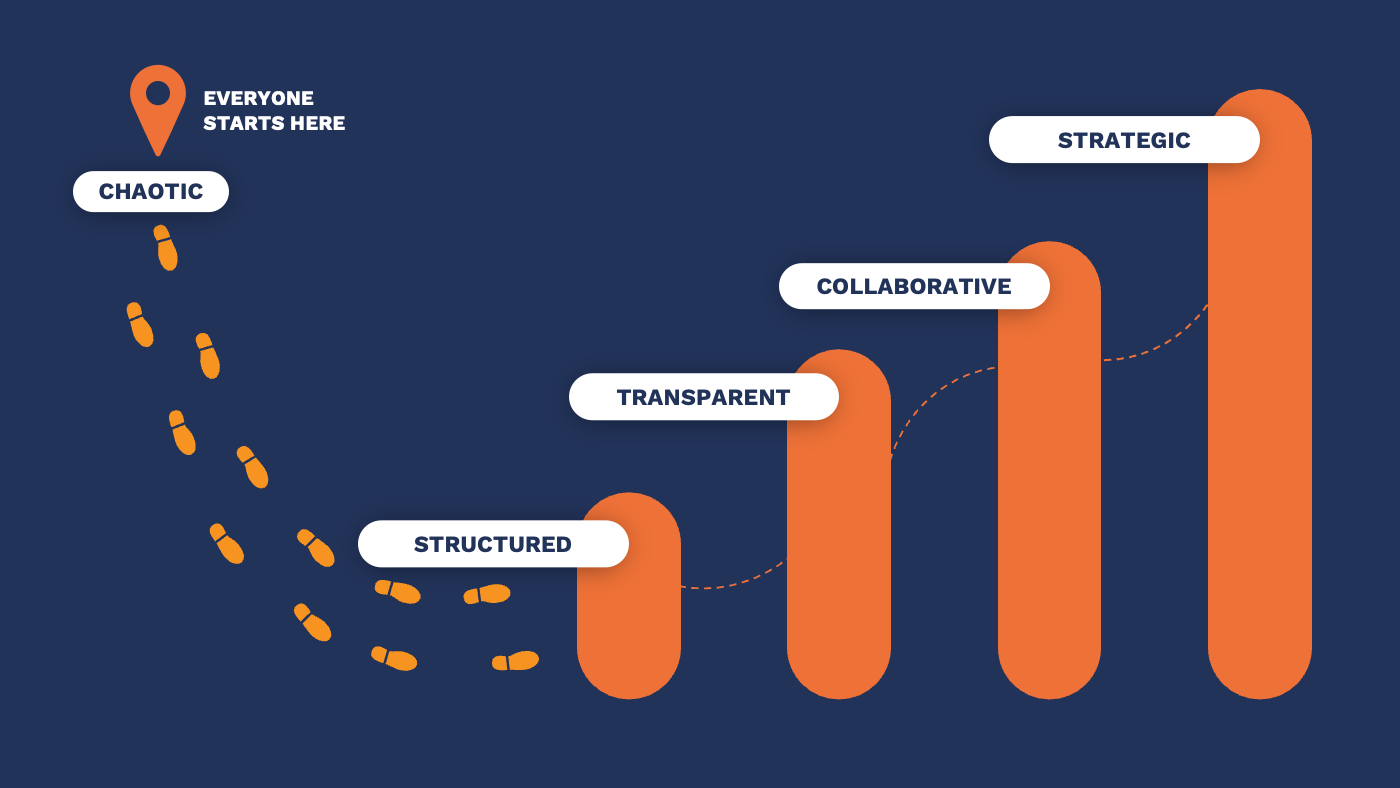
The Five Steps of Engagement Maturity
Engagement maturity measures client management scalability and value
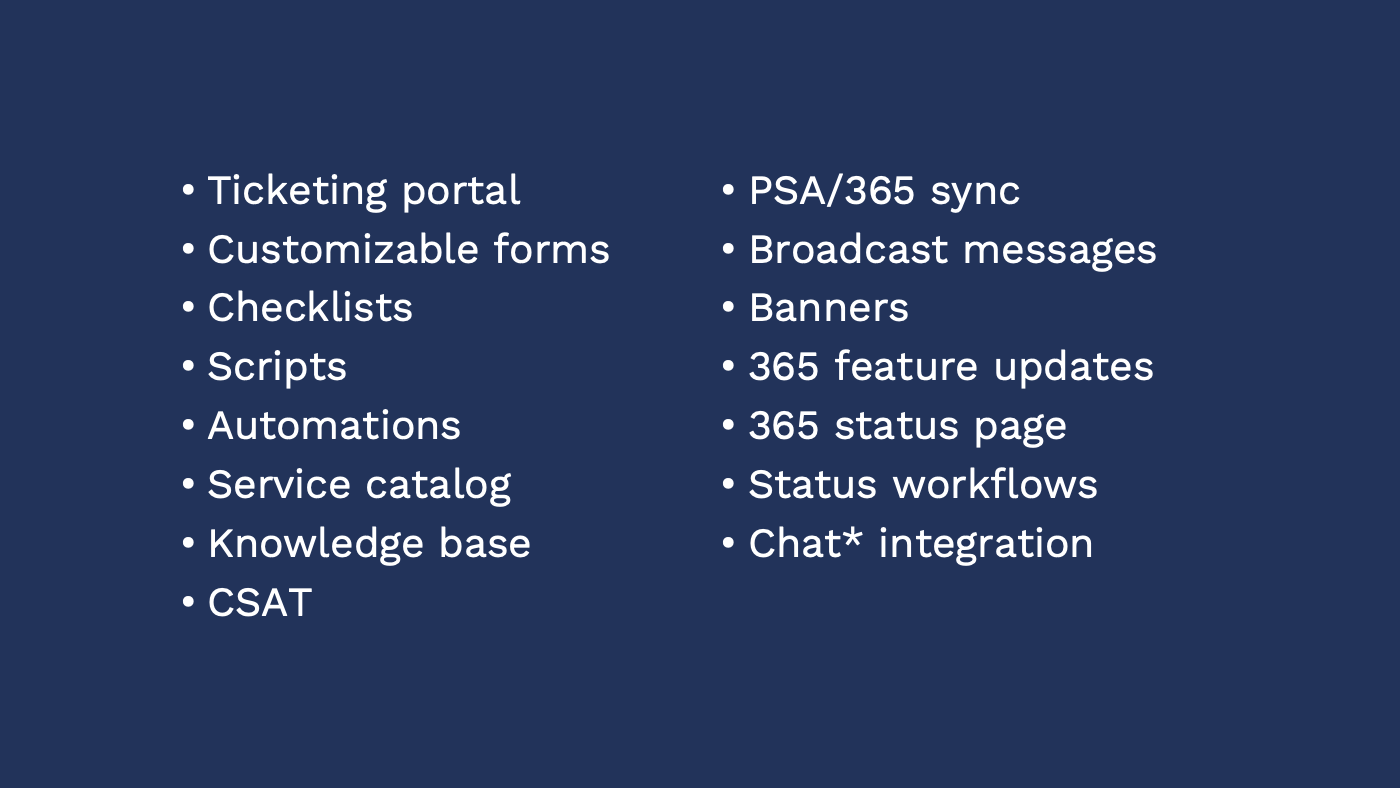
CSA Features at the Structured Level
Your portal streamlines client interactions
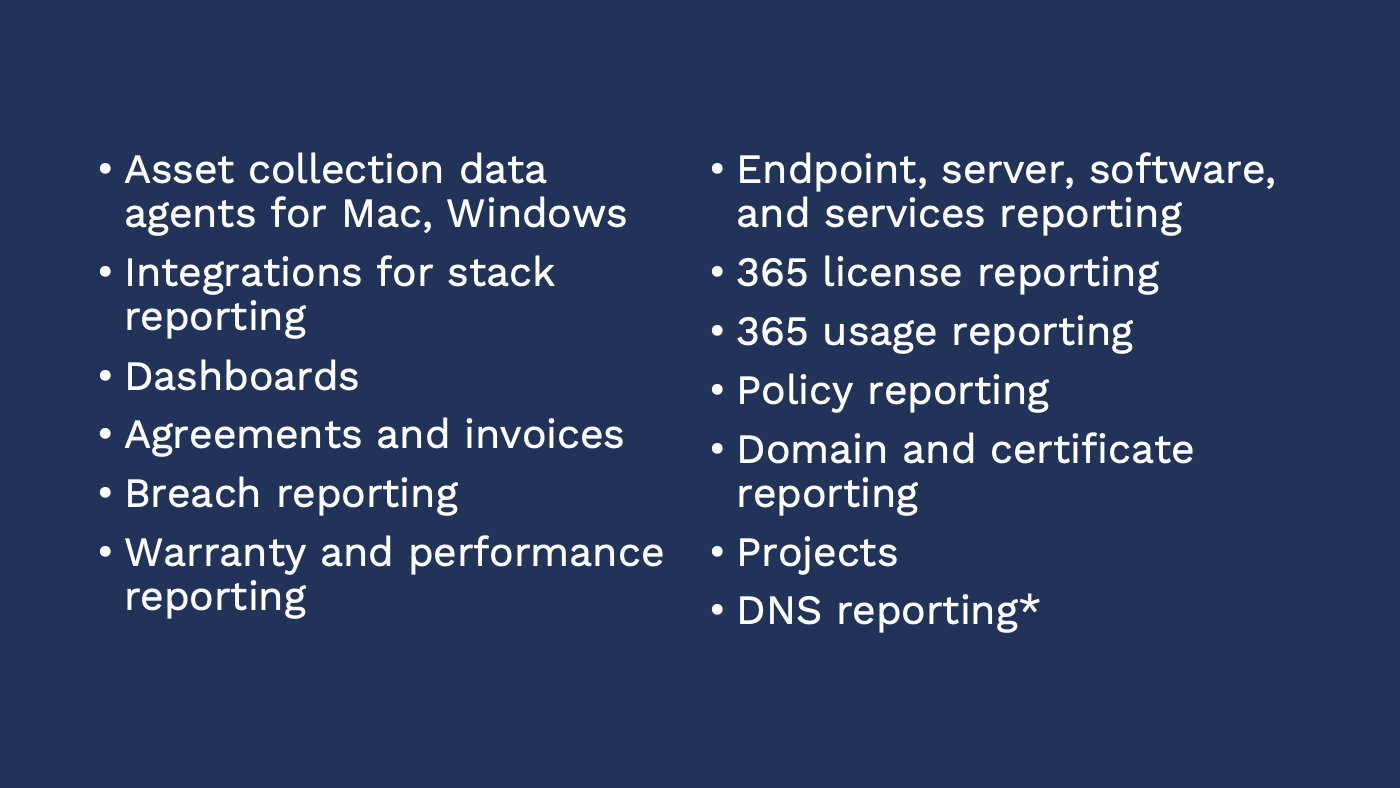
CSA Features at the Transparent Level
Stack integration lets clients see your value
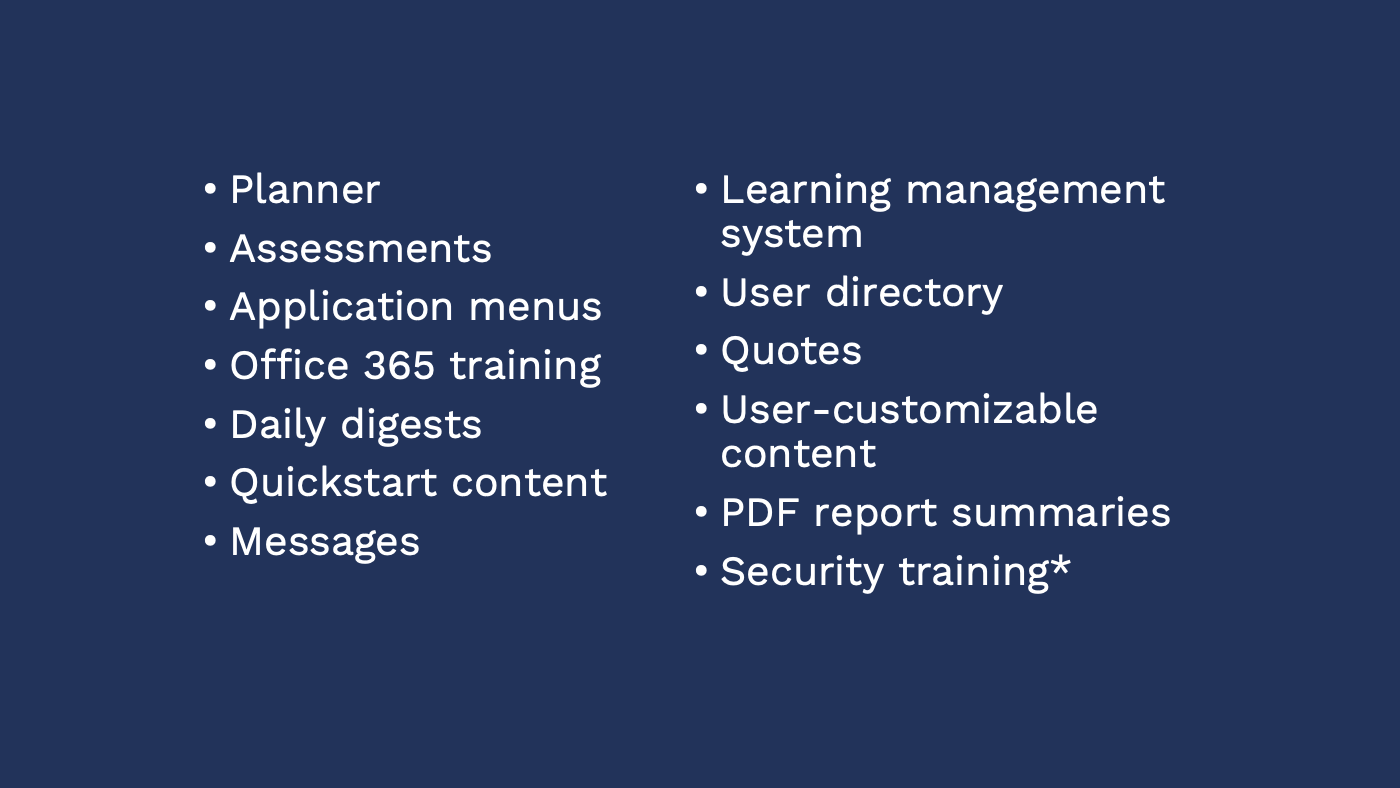
CSA Features at the Collaborative Level
Work with clients with on a common platform
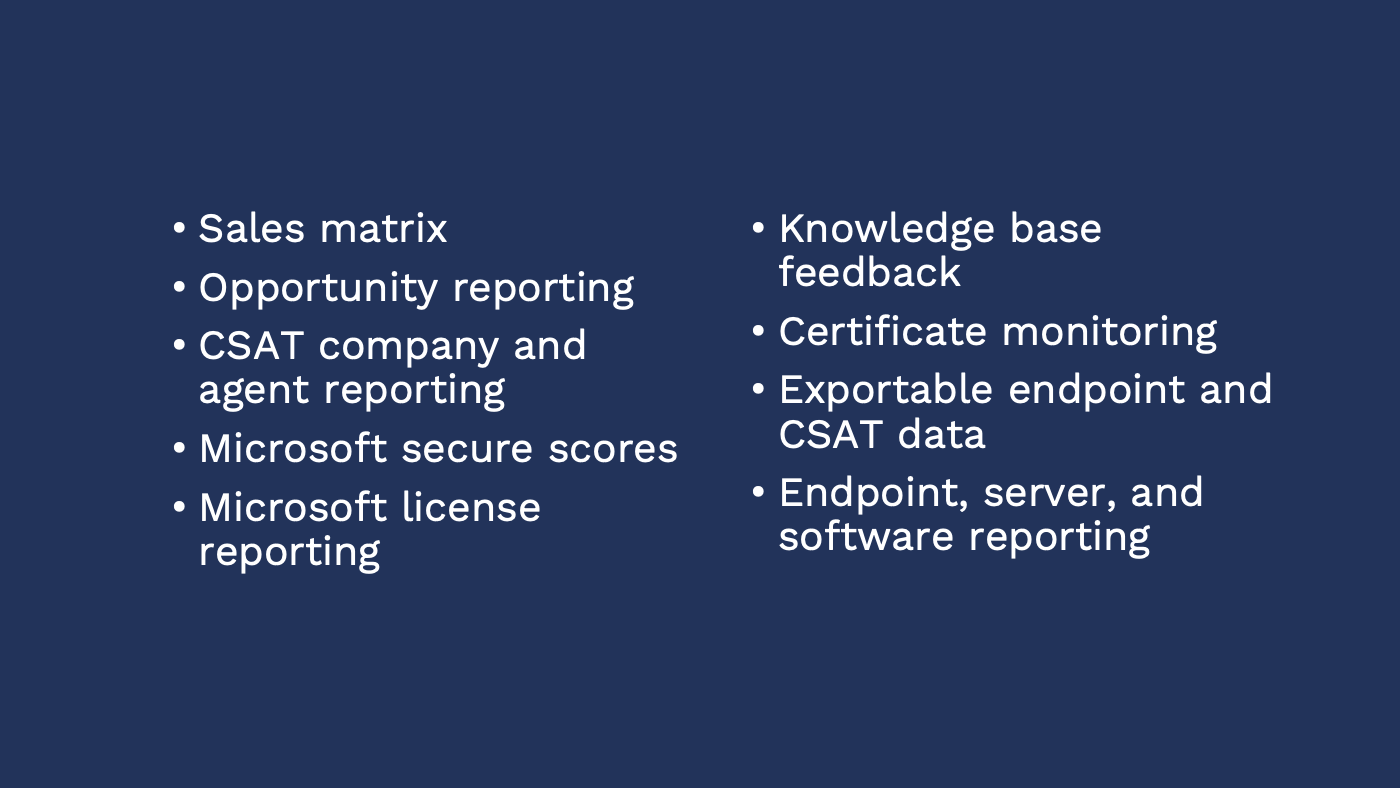
CSA Features at the Strategic Level
Work with clients as their trusted advisor
Each step of engagement maturity saves time, lowers costs, opens up new opportunities
Structured
Your portal streamlines client interactions.
BENEFITS
- Saves time for clients & service desk
- Improves service consistency and accountability
- Provides sales people a way to show and prospects a way to see what it is like to work with you
Transparent
Stack integration lets clients see your value.
BENEFITS
- Account managers save time with all client QBRs available 24/7
- Clients can access info they want on-demand, anytime
- Builds trust
- Reduces client frustration
Collaborative
Work with clients with on a common platform.
BENEFITS
- Allows working with clients in a common platform
- Provides you and your clients with a common set of data and reports
- Moves clients away from break/fix perceptions to that of trusted advisor
Strategic
Work with clients as their trusted advisor.
BENEFITS
- Discovers opportunities for more and higher margin MRR and projects
- Identifies new service opportunities
- Provides consolidated reporting for compliance, security, and policy exceptions
Engagement maturity is about looking at your MSP and the IT services you provide from the client perspective. It is everything client. Engagement maturity complements your operational maturity to deliver the client experience that showcases the effort you put into your tech stack. Engagement is the Yin (spirit) to your PSA and tech stack’s Yang (form). To be successful, you’ll need both engagement maturity and operational maturity.
This article covers engagement maturity and introduces the concept of a Client Services Automation platform that integrates and delivers a client experience that obsoletes traditional QBRs and removes the chaos of client relationships so they can become collaborative and strategic. If you have clients, you’ll want to understand engagement maturity and the CSA’s role in addressing the challenges to get there.
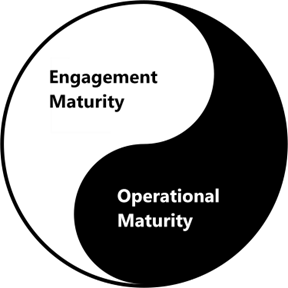
Jump to a specific section for more information
What is engagement maturity?
The best way to understand engagement maturity is to look at what we appreciate about commercial relationships. The best ones are:
-
Valuable – All relationships start here. Commercial relationships that don’t bring value, don’t survive very long.
-
Efficient – The provider makes it easy to transact business and solve problems accurately and with the least amount of effort.
-
Transparent – Data that supports the relationship is readily available, so trust is never an issue.
-
Communicative – There is a consistent two-way flow of information to address new challenges or resolve outstanding issues.
-
Insightful – The provider delivers advice and information that helps a client achieve their business goals faster or with less effort and cost.
The better the relationship, the more positive attributes it has. At a minimum, a relationship must have value. But beyond that, the relationship becomes increasingly beneficial when the other attributes are present as well. The higher the positive attributes, the higher the client engagement.
Engagement maturity is a way to measure the progress of your client relationships and a roadmap to improve those relationships.
Why is engagement maturity important?
To understand why engagement maturity is important, it is helpful to look at some common issues facing most IT service teams.
How would you answer the following questions from a prospect or fellow IT provider?
-
Is it easy for you to work with clients?
-
Do you make it easy for clients to work with you?
-
Do you make it easy for clients to buy new services from you?
-
Do you make it easy for clients to solve simple problems on their own?
-
Do tickets come in by email or phone making it difficult to triage and slower to resolve?
-
Are you proactively leading clients or reacting to their needs?
-
Is it easy for clients to understand what you do for them?
-
Is it easy for clients to know what you could do for them?
-
Do clients want or engage with your current QBR process?
-
Are QBRs hard to prepare?
-
Are routine client approvals hard to coordinate?
-
Do you make it easy for clients to find the information they need?
-
Do you know where your clients are heading?
-
Are you aligned with where they are heading?
-
Do you have a plan to help them get there?
-
Do your clients know your plans for them?
-
Is it easy for you to understand where your clients are heading?
-
Do 20% of your clients take 80% or more of your time?
-
Do smaller clients get any time or attention at all?
-
Do you have a way to demonstrate what it’s like to work with you?
These questions are all part of assessing overall client engagement, including both its quality and its effort to maintain. Good relationships that are difficult to maintain are just as at risk as poor relationships.
How is engagement maturity measured?
CloudRadial has created a client engagement maturity model that works for MSPs and internal IT service providers alike. This model measures client engagement maturity based on five levels. This model is called the IT Engagement Maturity Level™ (EML) and represents a measure of how well the relationship is working for both parties. It aligns well with the commercial relationship characteristics defined previously.
The five levels of EML are:
-
Chaotic – Client needs are addressed, but typically in one-off ways that lack process. All client relationships start at a chaotic level until their needs are understood and appropriate processes are implemented.
-
Structured – Problem reports and service requests come into service teams with complete information to reduce the time it takes to resolve issues and address opportunities.
-
Transparent– Information flows transparently to clients in ways they can understand and consume without much effort.
-
Collaborative – With requests and information flowing bidirectionally, IT service teams and clients are working from the same data and begin to effectively collaborate to address outstanding issues and new challenges.
-
Strategic – Collaboration leads to better understanding and with this understanding comes the necessary working relationship to better align IT service around business objectives built on solid technical foundations.
While each level can build on previous levels, each level can also work independently. For example, it is possible to be informative with clients but not highly structured with the way they communicate to you. Or a client can rank high both at the chaotic and strategic levels. Even different users within the client may judge the relationship differently.
Even without using the EML model, most IT teams have sought better relationships with their clients and often spend more time with larger, more demanding, or more profitable clients often at the expense of other smaller, less demanding, or less profitable clients. EML does not judge where time should be spent – it simply provides a measurement and a roadmap for improvement.
Let’s explore each level in more detail.
1. Chaotic
The Chaotic level, sometimes referred to as emerging, is where every client relationship starts. Chaos derives from some combination of a lack of understanding, a lack of processes, or a lack of product alignment. At the chaotic level, tickets typically come in by email or phone call and then are sometimes handled differently based on how they are triaged or who is assigned the ticket. At this level, it is challenging for you to effectively service clients with routine tasks such as onboarding and offboarding employees. With a lack of structure and organization, service staff often react differently to each request, which creates chaos internally and puts client satisfaction at risk.
2. Structured
Moving into the structured phase of EML starts to yield immediate improvements. At the structured level, you have made changes to its processes and protocols. Chaos begins to look more like order and reactive responses to client requests diminish. Starting at or building up to the structured level is built on the fact that you are getting the hang of things within your business and better anticipating client needs. You are starting to implement a structure and use software for both on the operations side and in client relationships. Processes are starting to become services with operational elements and hierarchies. They offer a consistent catalog, and their responses are focused. This reduces the time spent on routine client interactions. It also helps to improve efficiency and scalability.
3. Transparent
By progressing to the Transparent level of EML, even larger changes will come. At the Transparent level, one of the hallmarks is establishing trust by being more communicative. It involves using an evidence-based approach where everyone has all the same facts. It also manages built-in client reporting (often through its PSA) and creates branded products that are easy for clients to understand.
At the transparent level, you begin to understand that you owe it to clients to prioritize transparency, especially around accountability and operations. Communications at this level are proactive and you are starting to focus more on what you can do to build client loyalty.
Breaking down data silos is the key to turning data into information, and that information into actions.
4. Collaborative
At the collaborative level of EML, you interact with their clients in ways that are conversational and insightful. Trust has been built around a common set of facts, and insightful discussions start to occur. Your tools, processes, and standardizations have, at this point, become the norm – and not having to spend time managing data means you have more time to improve your client service. This leads to greater coordination of efforts and is more reliant on client feedback and discussion. This information is then used to map out the direction the business will take in the future.
At this level, all clients are provided basic insights and guidance. Importantly, the lifetime value of clients is increasing based on new opportunities. This level starts to really focus on client outcomes rather than client standards. This occurs by examining the client life cycle, maintaining an emphasis on client success, and involving predictable client service delivery.
5. Strategic
The strategic level of EML is marked by mutual trust between you and the client, where both parties participate in building efficiencies for how they work together. This trust turns into new insights and these insights better inform the building of efficiencies. At the Strategic level, you are at the table, working with clients and anticipating their needs. Your team is engaged in client success and working to develop and offer services that can scale as their clients grow.
| Chaotic | Structured | Transparent | Collaborative | Strategic | |
|---|---|---|---|---|---|
| Overview | This is where everyone starts out. The race is for clients and how you engage and service them gets figured out later. | With more clients come more operational issues. Now it’s important to get a handle on the inbound flow of information to speed resolution and service efficiency. | More clients mean more reporting and just adding a user to an email distribution. Clients deserve a better accounting of the services provided. | Client interactions start turning into conversations and collaborations. With less time spent on preparing and assembling data, more time is available to discuss what it means and what to do with it. | Collaboration leads to trust and clients want a higher level of conversation to make sure that their technology supports their business goals. |
| Characteristics | Each interaction typically stands on its own to solve the current issue. | Incoming information is structured to allow for consistent and scalable service execution. | Outgoing information is structured to help clients understand the services available or delivered. | Shared and centralized information speeds review and enables collaborative conversations. | Information has become insights that improve decision making and collaboration has become trust. The IT and client executive teams work together to solve high-level client business problems. |
Engagement Maturity Level Summary
The transformation from chaotic to strategic relationships is different for everyone. What is consistent is that at every stage there are tangible benefits that encourage you to keep evolving your client relationship. Client engagement is becoming increasingly more important as IT work has migrated to the cloud and is now based more on intellectual property (unseen) than labor (seen). Next, we’ll focus on the internal changes that elevate engagement maturity.
How does engagement maturity affect people, processes, and products?
Improving engagement maturity involves updating people, processes, and products to better resolve client challenges. While assessing your current abilities, it’s important to be as objective as possible while constantly trying to visualize the relationship from the client’s perspective.
During this review, you may find that your people are highly focused on servicing your clients, but that your processes are reactive. You likely have evidence of that disconnect in your support ticket response loop. Another example is you may have consistency with delivering QBRs, but you don’t have an organized, branded service catalog. This demonstrates another area that is likely causing issues regarding how well your team can upsell to existing clients.
We’ve taken the engagement maturity model and mapped it to an easy assessment matrix that will show you where you stand on the EML model. This matrix give you feedback on what areas to work on and how to leverage the platform to help with your evolution to the engagement maturity level you want to be in.
| Chaotic | Structured | Transparent | Collaborative | Strategic | |
|---|---|---|---|---|---|
| People | • Communications are random and unstructured – typically through email and phone. | • Typically, transactional with an increasing percentage of inbound communications coming through online forms and more structured methods. | • Increasingly proactive with information designed for self-service or IT understanding. | • Increasingly planning oriented with everyone working from common data and presentations. | • Conversant with client executive team and integral to client’s business success. |
| Processes | • No processes. Reactive. | • Defined support processes for engaging with clients. • Increasing use of standard SOPs and scripts for tickets. • Business reviews, if done, aligned with IT stack and other technical requirements. • Activities focus around “noisy”, “needy” or larger clients. • Feedback mechanisms in place to capture client sentiment. |
• Defined information delivery to clients in business-centric presentation available 24×7. • Consistent execution across service staff. • Business reviews, if done, a combination of technical details and service catalog items. • Larger clients provided more information and attention. |
• Consistent execution across account managers. • Business reviews aligned with matching service catalog with client needs. • IT management has summarized the status of each client. • All clients provided basic insights and guidance. |
• Consultative business reviews 100% focused on alignment with client business direction. • Discussions identify and generate the requirements for new projects and opportunities. |
| Product | • Different contracts or services for different clients. • Products often reference vendor branding. |
• Single product or service with multiple tiers becoming consistent across clients. • Products explain how to consume IT service capabilities. • Products technically focused on IT capabilities. • Reduced or no vendor branding. |
• Products branded to the service provider. • Products provide clear benefits to clients. • Multiple products and tiers aligned around a combination of technical and business requirements. • No vendor branding. |
• Multiple products aligned only around client business needs. • Products offer defined benefits that businesses need to operate their business. |
• Products and tiers aligned around business needs across multiple levels of client business technology requirements. |
People, process and products can be more readily summarized as:
| Chaotic | Structured | Transparent | Collaborative | Strategic | |
|---|---|---|---|---|---|
| People | Random | Focused | Communicative | Conversational | Executive |
| Processes | Reactive | Service Oriented | Automated Reporting | QBR Consistency | Entrepreneurial |
| Product | Sell Anything | Consistent Catalog | Branded | Client Aligned | High Margin |
How does engagement maturity relate to operational maturity?
Operation maturity levels were defined by Service Leadership, now a ConnectWise company, to define a path of internal and financial improvement.
Engagement maturity mirrors that journey, but from the client side. You’ll notice that as you progress operationally, there is also an opportunity to improve engagement. Many of the core systems you implement operationally also support engagement benefits if you look for them.
| Chaotic | Structured | Transparent | Collaborative | Strategic | |
|---|---|---|---|---|---|
| Corresponding Operational Maturity Level | OML 1 – Beginning Low to negative financial performance and inconsistent service quality. They don’t know what they don’t know. Operations are largely trial and error. |
OML 2 – Emerging Low to negative financial performance and inconsistent service quality but starting to understand the basics of profit levers. Few controls and little forward planning. Incentive compensation isn’t meaningful and/or is poorly aligned. |
OML 3 – Scaling Median financial performance and service quality. Basic controls. Some forward budget planning, little attainment tracking. Incentive compensation is meaningful in scope but not tied to budget attainment. |
OML 4 – Optimizing High financial and service quality performance. Robust controls. Detailed forward budgeting and attainment tracking. Incentive compensation is meaningful in scope and tied to budget attainment. |
OML 5 – Innovating Highest financial performance and highest value and quality services. The characteristics are similar to OML 4 but they also now extend capabilities to lines of business adjacent to IT. |
Who benefits from improving engagement maturity?
Improving engagement maturity pays regular dividends in reduced workloads, more opportunities, higher revenues and margins, better client relationships, and improved satisfaction for both clients and IT staff. Improving EML becomes a natural part of business reviews internally and externally. Each audience sees EML success a little differently.
Service Managers
Service managers get more from their service team when there are fewer tickets and when those tickets are handled in predictable ways. Removing chaos and wasted effort from support efforts are top of the list when it comes from improving EML but there are more:
-
Optimized triage – Getting issues to the right people faster can make a big difference in time to resolution.
-
Improved consistency – Advanced understanding of problems provides the opportunity to put plans and processes in place so that problems or service requests are handled faster and with less effort.
-
Less back and forth – Getting all the information required at the very beginning of the process reduces emails, phone calls, scheduling, and general confusion.
-
Prevention – Anticipating self-service opportunities to common problems is the fastest way to head off tickets, especially when the resolution can be provided without delay.
-
Improved SLA compliance – Responding and closing issues faster improves SLA scoring, which is one measure of client satisfaction.
-
Feedback – Gathering client input as a ticket is ongoing is a key part of making sure the outcome is heading towards a positive client experience.
Higher EML is one of the fastest ways that service managers can do more with the same number of support staff. Plus, everyone has less stress when there are fewer truly exceptional or problematic issues.
Account Managers
Account managers often know they could be more proactive if they only had less reactive issues to deal with. In other words, if customers would quit calling, more time could be spent calling customers.
With a higher EML, account managers gain:
-
Reduced preparation time – As information becomes easier to access or is automatically gathered, preparation time is greatly reduced.
-
Increased presentation time – If information has already been communicated to clients, less time is spent on routine status updates leaving more time to talk about opportunities that have real impact on client goals.
-
Improved meeting responses – When less time is spent on status information and there is more time to talk about what the clients want to discuss. When clients are driven by client needs, they become much more receptive to holding regular business reviews.
-
Scalability – With less time spent reacting and preparing, an account manager can handle more clients with less effort and in more consistent ways.
-
Interchangeability – With defined and proactive processes, it is easier to create consistency in the way each client is handled, which means that multiple account managers approach their jobs in similar ways and with similar goals.
-
Frequency of touch – The flow of information to clients lets them feel more connected to what is being done on behalf of their company.
-
Wider end-user insights – When clients can view information on their own schedule, they find things they miss in structured reviews.
With information less siloed and more accessible, account managers, just like clients, can more readily see the bigger picture and find opportunities that would otherwise be lost in the noise of unorganized or inaccessible data.
MSP Owners
Whether MSP owners are looking for a lifestyle business or growth-oriented business, they both derive from the same place – improving efficiency. With increased efficiency, less time is spent doing routine tasks and that provides more time that can be used to relax or that can be used to land new clients.
In addition to the efficiencies and scalabilities mentioned above, MSP owners will see:
-
Profit improvements – The overall impact of service and account management improvements shows up in improved margins and on the bottom line.
-
New opportunities – More strategic conversations with clients provide insights on new projects, new MRR opportunities, and even new business directions.
-
Competitive differentiation – When a business is working well with both operational and engagement efficiencies, it becomes apparent to prospects evaluating your services.
-
Lower risk – Improved processes and a more proactive approach to providing clients with information reduces the risk of churn and lawsuits arising because of a lack of communication.
-
Higher valuation on exit – Improved margins, engaged clients, and higher client retention has appreciable impact on the overall business value.
Creating a service business that has a strong and demonstratable client focus is something any owner will be proud of.
Internal IT Teams
Though internal IT has only one client to support, paying attention to EML can have a huge impact on the organization and dramatically improve the quality of life for IT support staff including:
-
Receiving complete requests – Using a structured approach to gathering ticket information dramatically reduces the time it takes to solve tickets.
-
Reporting for non-technical management – More organized information helps those managing the IT function understand what is being done daily to maintain compliance, continuity, and security.
-
Aligning IT with outcomes – Internal teams may feel disconnected from company goals unless they migrate from being viewed as a cost-center into a source of new opportunity and cost savings.
-
Improved budgeting – Putting needs into easy-to-understand roadmaps helps CFOs assess the needs and benefits of long-term planning.
It seems that internal teams would naturally work closely with the rest of the organization due to their proximity. But the fact that IT work can be so different from the rest of the company’s objectives makes communication and coordination key methods for internal teams to be viewed positively.
Clients
Most clients don’t start businesses so they can buy legal services, tax services, insurance, or IT services.
But, as essential services, clients need experts in these fields to grow their businesses. But, more importantly, clients need to feel that they have made the right choices and ideally feel that their providers are helping ensure their success rather than just being a necessary expense.
For clients to appreciate (and even brag about) their IT service provider, they need to:
-
See tangible proof of service and accomplishments.
-
Understand and anticipate upcoming changes and improvements.
-
Observe spill-over benefits into other company functions, such as human resources and compliance.
Clients should feel smarter for having chosen their IT service provider. Improved EML ensures they do.
Benefits Summary
Each step up in engagement maturity leads to progressive benefits for both clients and IT services.
Initial benefits are immediately apparent for service delivery. Successive levels begin improving account management and the strategic direction of the relationship. Even improving just one or two levels can improve your efficiency and profits.
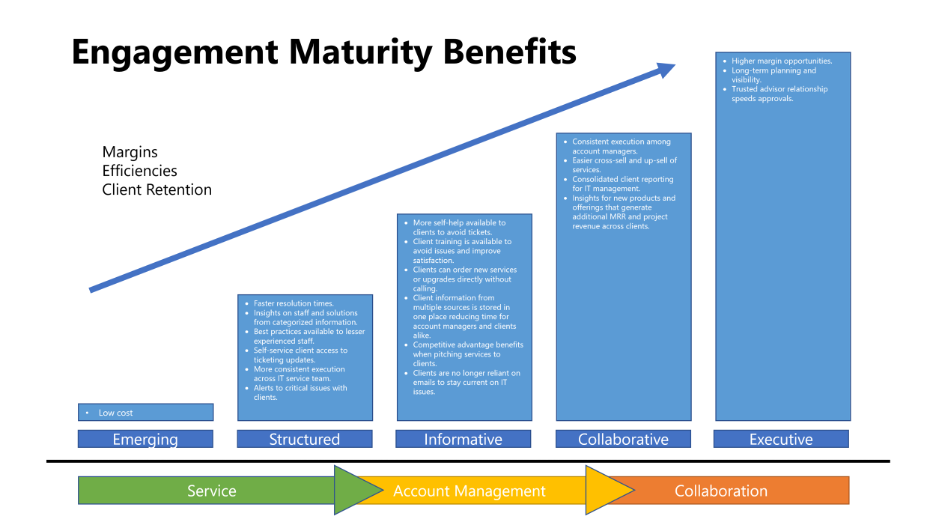
The following table defines these benefits in more detail.
| Chaotic | Structured | Transparent | Collaborative | Strategic | |
|---|---|---|---|---|---|
| Benefit | Break/fix approach to clients is the simplest method to implement. | Reduce time and improve efficiency and scalability in routine client interactions. | Reduce time and improve efficiency and scalability in client reporting and self-service options. | Reduce time and improve efficiency and scalability of client business reviews and the coordination of efforts. | Use newfound efficiencies and collaboration to discover strategic opportunities. |
| Details | • Low cost. • Easy to implement. • Pricing within reach of even the smallest clients. |
• Reduce email and phone tickets. • Eliminate the need for clients to rely on email for ticket updates. • Create dynamic form-based tickets and service requests for faster ticket resolution times. • Easily customize forms for different clients or different types of clients. • Easily pre-triage tickets to route and categorize issues faster. • Reduce tickets using banner alerts to address outage and other issues. • Manage and document approvals and workflows to ensure the right people are alerted as needed. • Provide anywhere access to your resources through the web, desktop and in Microsoft Teams. • Create PSA checklists and scripts from tickets to ensure best practices and consistent responses across all support staff. • Synchronize users between 365, your PSA to create an accurate list of supported users. • Recognize staff who are generating superior results and get alerted when clients have concerns. • Provide always available ticket summary reporting for client management. |
• Provide knowledge base, training, and other help resources to improve security and allow for 24×7 client self-help. • Enable client self-service ordering for new services or upgrades directly without calling or quoting. • Improve client productivity and collaboration by giving them the training to make the most of 365 and the other services you provide. • Consolidate all your client reporting in a single portal eliminating email and multiple portal logins for clients and account managers. • Automate report generation through 3rd party integrations and easy email reporting interfaces. • Eliminate Office 365 administrative questions through transparent reporting of 365 usage, adoption, and licensing. • Eliminate routine invoice or account questions through transparent reporting of invoices, agreements, and quotes. • Make all your client reporting understandable and actionable by organizing information in the way clients view your services. • Proactively keep clients up to date with security or service updates through email, broadcasts, and messages. • Differentiate your services to prospects by showcasing data transparency and always available reporting. |
• Reduce business review preparation time through automated and consolidated reporting in a single platform. • Create consistency among account managers by providing consistent processes to follow. • Define assessments that spot missed security, continuity, productivity, or collaboration opportunities. • Enable easier cross-sell and up-sell of services through recommendations. • Visualize every client’s progress towards full stack implementation through a single sales matrix. |
• Create a “boutique” experience for clients with their own customized portal built around their brand and content. • Focus on higher margin projects and MRR opportunities. • Create long-term planning and visibility for clients and service teams. • Get quotes approved faster using the trust built through transparency. |
There are other benefits beyond just improvements with existing clients. As you move up in your EML abilities, you are better positioned to handle larger or more complex clients or projects. The ability to collaborate and discuss business outcomes strategically are the key elements of this success.
How does engagement maturity facilitate the vCIO role?
When IT service teams work with clients, you’ll often hear the terms “trusted advisor” and “vCIO”. Though sometimes used interchangeably, they are very different, and someone can be one without being the other.
First, let’s define the terms more completely.
-
Trusted Advisor (TA) – Someone who provides advice, guidance and recommendations on a particular subject defined by industry best practices. Someone who is trusted because of experience, certifications, recommendations, or an accumulated history of work.
-
CIO – Someone who understands and oversees the people, processes, and technologies of a company’s IT organization to ensure they deliver outcomes that support the goals of the business. (Gartner)
-
vCIO – Someone who delivers CIO services for multiple clients on a shared basis.
Trusted advisors make sure that businesses are doing things correctly. CIOs are C-Level executives who work with company management to help the business use technology competitively. CIOs often use trusted advisors to help them achieve those goals. CIOs are more involved with the “why”. and TAs are more interested in the “how”.
The vCIO role is similar, and though it is technical, it often requires the help of internal TAs to help plan out complex issues (such as Azure migrations). TAs maintain the status quo by providing consistent levels of performance with continuing improvements. CIOs are often looking to change the status quo to deliver improved competitive advantage, lower costs, or bring on new products or services.
At the strategic level, the IT provider is aligned with client needs and has migrated from the collaborative TA role to the strategic CIO role. The strategic role is the pinnacle of maturity because if the “how” works well, more time is available for the “why”.
How does engagement maturity anticipate change?
The role of managed services and IT has been and is constantly changing as technology changes. As businesses struggle to maximize the usage of technology, you will find yourself continually translating the generic tools provided by Microsoft, Amazon, and others into specific solutions for businesses.
Even before Covid, 92% of businesses thought their business models would change due to digitalization. The solutions small and medium businesses will require in 10 years will be as different then as they are today from what was required 10 years ago.
Each decade has brought about significant changes in the tech landscape:
-
1990’s – Local area networks
-
2000’s – Local servers and Internet
-
2010’s – Cloud services
-
2020’s – Security and compliance
-
2030’s – Orchestration?
Large firms like Microsoft, Amazon, Dell, Google, and Apple drive innovation and market shifts. But it is up to IT teams to take these opportunities and translate them into benefits for the small and medium businesses (SMBs) they support. Complexity is ever increasing, and clients require outside expertise that isn’t core to their day-to-day business.
The best way to thrive as technologies change is with a strategic understanding of where your clients are headed. This understanding drives future projects, growth, and revenue.
How does engagement maturity affect the client lifecycle?
We have previously written about the four key stages of a client’s journey. A solid client engagement strategy improves every step of that journey.
| Chaotic | Structured | Transparent | Collaborative | Strategic | |
|---|---|---|---|---|---|
| Land | Client focuses on price and likability. | Clients understand the service they will be receiving. | Clients understand what their MSPs will be doing. | Clients understand how a great vendor relationship should look. | Clients are adding a technology specialist to their executive team. |
| Onboard | Clients just start calling and emailing. | Clients are shown how to get problems resolved faster. | Clients are shown what to expect and how to monitor. | Clients participate in completing assessments and identifying changes they’ll need to make at the time of go-live. | Clients are briefed on the plans and status of roll-out and acceptance of security and process changes. |
| Manage | Ad-hoc. | Mange to SLAs and CSATs. | Clients are fully informed of their environment. | Regular client conversations to review business focused needs and projects. | Clients and providers routinely participate in executive level discussions. |
| Grow | Based on client needs. Fast growing clients often outgrow their MSP provider. | Better identification of issues generating many service requests. | Clients start ordering directly and requesting projects based on the information provided. | Growth becomes incorporated in an overall client plan that is presented to and understandable by clients. | Long term planning with discussions focused on company, and often MSP, changing opportunities. |
Here are some questions that can help you determine if improving your EML has benefits at each stage of the client lifecycle.
Land
-
Do you have a killer way of working with clients that helps you close new business?
Onboard
-
Do you want to create custom forms unique by clients (or groups of clients) to speed the onboarding and off-boarding of employees/users?
Manage
-
Do you want to make it easy for your team to work with clients?
-
Do you use automation and an online portal to save time and make it easier for your service and account management staff to do their jobs while also improving the client experience?
-
Do you want to promote self-help and training to avoid tickets?
-
Do you want to get all the information you need on the first ticket?
-
Do you want your tickets to come complete with an SOP and scripts developed around the best practices from your best techs?
-
Do you want to keep your PSA and Office 365 in sync automatically with no extra effort?
-
Do you want to have an easy way to work with internal IT teams with a co-managed and collaborative solution?
-
Do you want to have a single place to store all the security information a client needs for compliance?
-
Do you want to add training to your offering or as a paid add-on offering no or little additional cost?
-
Do you want to offer clients self-service reporting for Office 365 licenses, usage, and security?
-
Do you want your clients and users to get this information at any time from any device including the web, Teams, and a desktop application?
-
Do you also make it easy for clients to work with you, benefit from your expertise, recognize your value and see you as their trusted partner?
Grow
-
Do you want account managers to spend less time gathering information?
-
Do you want account managers to have time to be proactive and cross-sell other solutions?
-
Do you want account managers focused on all clients rather than just a few clients due to time constraints?
-
Do you want to offer a client-branded custom portal to deliver a boutique experience to all your clients?
-
Can you easily scale your business when you add new clients, new capabilities, and new solutions?
-
Do you want to quickly see where all your clients stand with all your key product offerings?
What is a Client Services Automation (CSA) platform?
For relationships to be worthwhile, they must be profitable. To be profitable, these relationships must be scalable. To be scalable, they must be automated, repeatable, and measurable.
By now, it should be plain that improving EML is a task that is not only useful for profitability but also necessary for future success.
Engagement maturity can be addressed by a collection of ad-hoc point solutions – but this is basically a break-fix approach.
Do clients need better reporting? Get a tool. Do clients need better QBRs? Get a tool. Want to collect feedback? Get a tool. With this approach, you may be improving EML – but at what cost to you, in terms of tools and a lack of integration? The current situation looks something like this.
Client Engagement without a CSA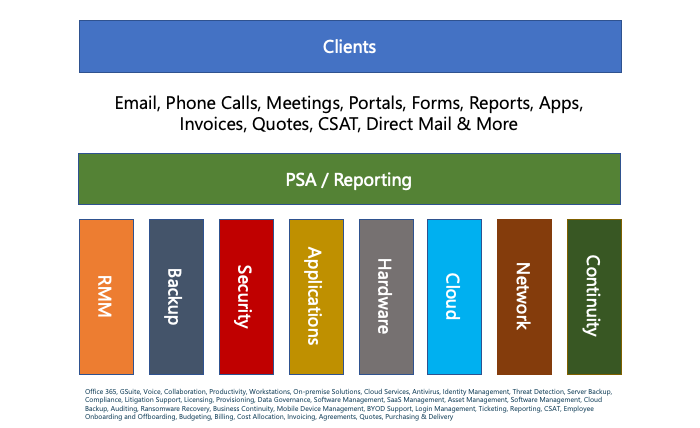
With these problems in mind, CloudRadial pioneered a new class of product known as a Client Services Automation, or CSA, platform. The CSA integrates all client touch points into a single pane of glass that brings everything together for client consumption and account management productivity.
The Client Services Automation (CSA) platform is a digital-first approach to managing clients. It replaces or consolidates previous client touchpoints in one branded portal that represents service delivery from a client perspective.
The CSA relies on automation and integration that lets relationships scale even as new clients are added and personnel change. It allows clients, service staff, account managers, and MSP owners or IT managers to work together in a way that drives efficiency, sharing, and collaboration while allowing time for more strategic conversations.
The CSA replaces the noise of client interactions with a single window into all client engagement for both the client and you.
Client Engagement with a CSA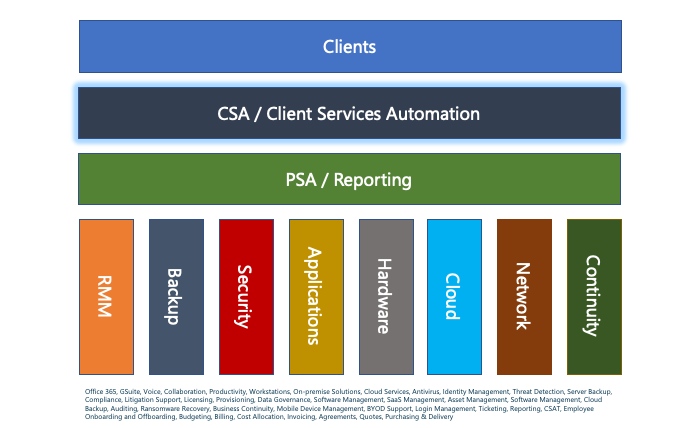
The CSA complements and enhances the PSA you use. If the CSA and PSA don’t work seamlessly together efficiencies are lost. In the ideal world, technical staff continue to use the tools they use today including the PSA. Then the CSA layers on top of things to bring all the MSP efforts into one client facing presentation. Just like the engagement maturity is the Yin to operational maturities Yang, the CSA and the PSA have the same relationship. One works better when the other is also deployed.
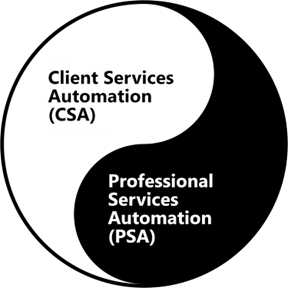
| PSA (Professional Services Automation) Operational Maturity Features |
CSA (Client Services Automation) Engagement Maturity Features |
|---|---|
| Ticketing Time tracking Procurement Agreements SLAs Billing Quoting |
Service catalog Knowledge base Training Reporting Policies Assessments Planning & roadmaps |
CloudRadial’s Client Services Automation (CSA) platform transforms the way you and your team engage, collaborate, and advise clients and end-users. It consolidates all the IT touch points of ticketing, reporting, training, planning, and account management into a shared portal where clients and IT collaborate to resolve problems, understand issues, add new services, and plan future opportunities.
How does engagement maturity work in the real world?
Now that we’ve come to understand the value of higher engagement maturity and the features that make up a CSA platform, you’ll see that CSAs allow engagement maturity to be implemented at scale.
Partners are constantly telling us how CloudRadial helps them solve key business challenges. Partners who have deployed CloudRadial and addressed their EML challenges see significant benefits:
Strategic Impacts
-
Improve competitive position
-
Improve ability to support growth
-
Easier to Introduce new products
-
Improve customer satisfaction
-
Greater confidence to serve new markets and customers
-
Enhance profitability
Operational Impacts
-
Improve service / account management availability
-
Improve capacity to scale
-
Improve employee productivity
-
Improve employee performance consistency
-
Less time to onboard new clients
-
Shorter account management preparation times
Financial Impacts
-
Improve revenue
-
Improve gross profit
-
Reduce operating costs
Risk Impacts
-
Reduce retention risk
-
Reduce workforce / talent risk
-
Reduce legal risk (solutions presented/declined)
Please read the following success stories to learn more about specific improvement.


